The final World Cup spot was up for grabs on Tuesday afternoon. Just one more game had to be played to decide who the 32nd team would be to battle it out in Qatar in November for the greatest honour in the beautiful game.
The stage was set. Costa Rica and New Zealand were preparing to go head-to-head with each other to claim the final allotment in the World Cup at the Al Rayyan Stadium in Doha, Qatar, giving the two continental titans a teasing taste of what’s to come.
Costa Rica had an edge over the All Whites in the form of their manager Luis Fernando Suárez. The 62-year-old had already guided Ecuador to the World Cup in Germany in 2006 and Honduras to Brazil in 2014.
The Ticos were on the verge of qualifying for their third World Cup on the bounce but had seen some mixed results in their warm-up games, losing 2-0 to Panama while beating Martinique by the same score.
On the other hand, New Zealand didn’t fare much better, drawing to 0-0 to Oman and losing 1-0 to Peru.
Nevertheless, it was Costa Rica who will return to Qatar once more in a few months’ time for the 22nd official FIFA World Cup.
This article will be a tactical analysis of how the Central Americans overcame the Kiwis. It will be an analysis of the tactics used by both Suárez and Danny Hay which led to the game’s outcome.
Lineups and formations
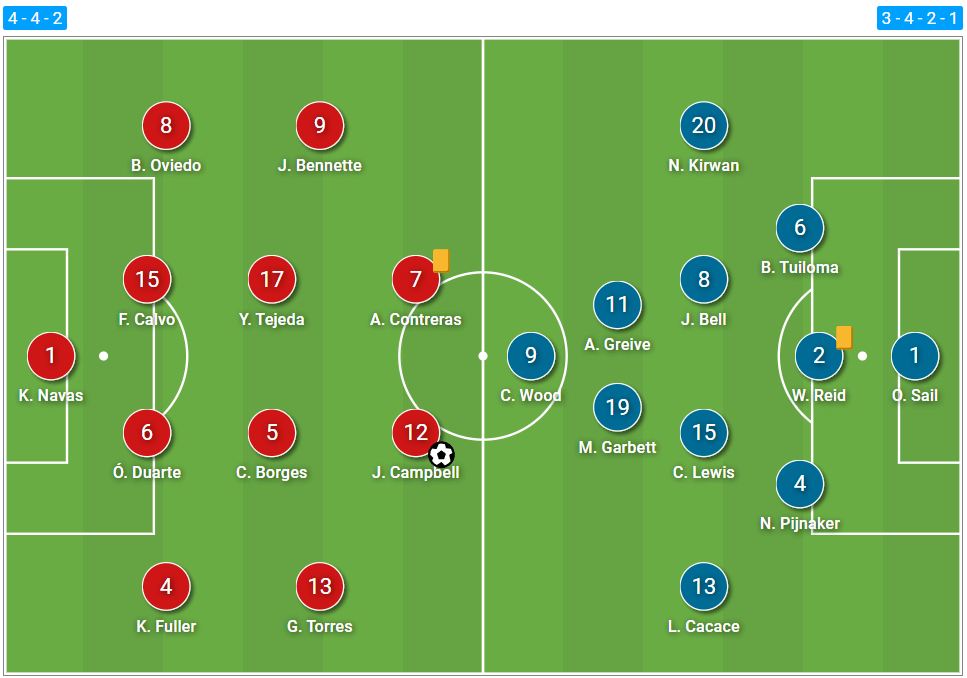
Having taken them thus far, now wasn’t the time for a radical tactical change from the Costa Rican boss. Suárez’s players took to the field, setting up in a 4-4-2 base formation.
The former Real Madrid and current PSG goalkeeper Keylor Navas played between the sticks as the Ticos’ captain, protecting the goal behind a back four comprising of the ex-Everton and Sunderland fullback Bryan Oviedo, Francisco Calvo, Oscar Duarte, and Keysher Fuller.
The double-pivot ahead of the backline was made up of the experienced Celso Borges and Yeltsin Tejeda who are both on the wrong side of 30 but offered calm, composed heads in such a momentous clash. The pair were flanked by Gerson Torres on the right and Jewison Bennette on the left.
Meanwhile, the former Arsenal starlet Joel Campbell played alongside Anthony Contreras as the strike partnership to round off a very strong lineup from Costa Rica.
However, New Zealand brought their A-game too, with Hay fielding an incredibly resilient starting eleven full of quality within his preferred 3-4-2-1.
Oli Sail was given the nod in goal, as usual, with Nando Pijknaker, Winston Reid and Bill Tuiloma making up the back three. Niko Kirwan and Liberato Cacace were positioned as the wingbacks, supporting the backline in the defensive phases but providing New Zealand’s only source of width going forward.
Joe Bell was chosen by the manager to sit in the double-pivot alongside Clayton Lewis while Matthew Garbett and Alex Greive flanked Newcastle United’s Chris Wood in the advanced areas of the pitch.
A lazy tendency in the football community is to believe that great tactical clashes come from the titans of the industry. A Pep Guardiola versus Jurgen Klopp stalemate would be considered one of the greatest chess matches of our time.
However, this World Cup playoff clash was one of the most tactically enthralling matches of 2022 so far. Forget Guardiola versus Klopp, or Thomas Tuchel versus Carlo Ancelotti, Suárez and Hay put on a tactical masterclass for the ages.
Costa Rica’s gameplan
Let’s begin by analysing Costa Rica’s approach in the game. Suárez knew that New Zealand are a side that like to dominate possession, and so instead of fighting back against this in a brutal tug of war for the ball, Costa Rica allowed their opponents to keep it.
Overall, Costa Rica held just 36.87 percent of the possession share compared to New Zealand’s 61.13.
The Ticos dropped off into a compact 4-4-2 medium-level defensive block, denying the Kiwis access to spaces or players between the lines.
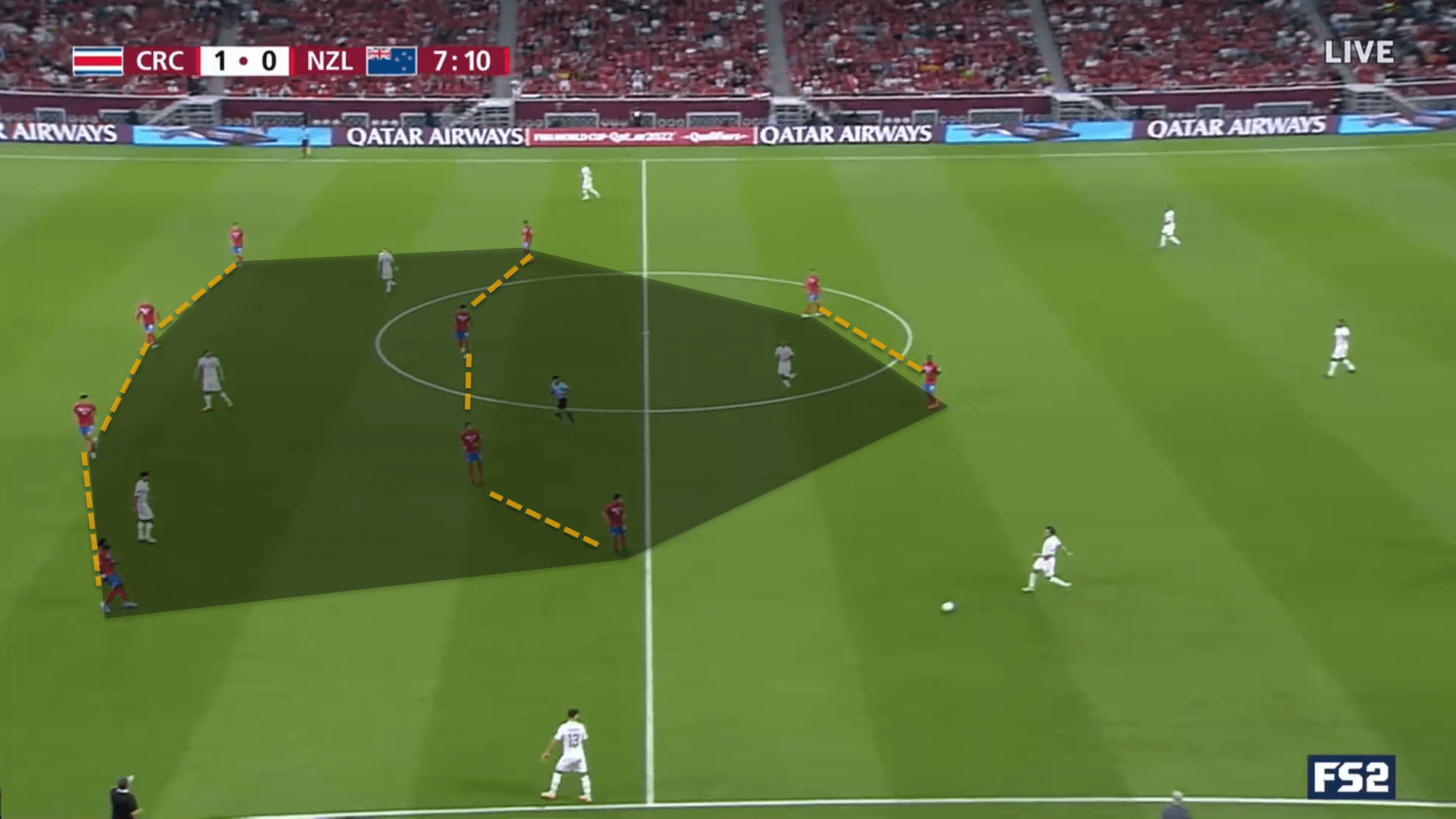
Suárez also knew that their opponents love to play balls in behind to runners when the opportunity arises and so wasn’t keen on allowing his men to press high. This is because, if the press was broken, Costa Rica’s backline would be exposed and so Hay’s side would be able to take advantage of the space by playing balls in behind.
Hence, New Zealand could pass the ball out from the back unscathed without any pressure being applied by the Costa Ricans. The Central Americans’ held a Passes allowed Per Defensive Action (PPDA) rate in the first half of 21.4, showing just how passive they were.
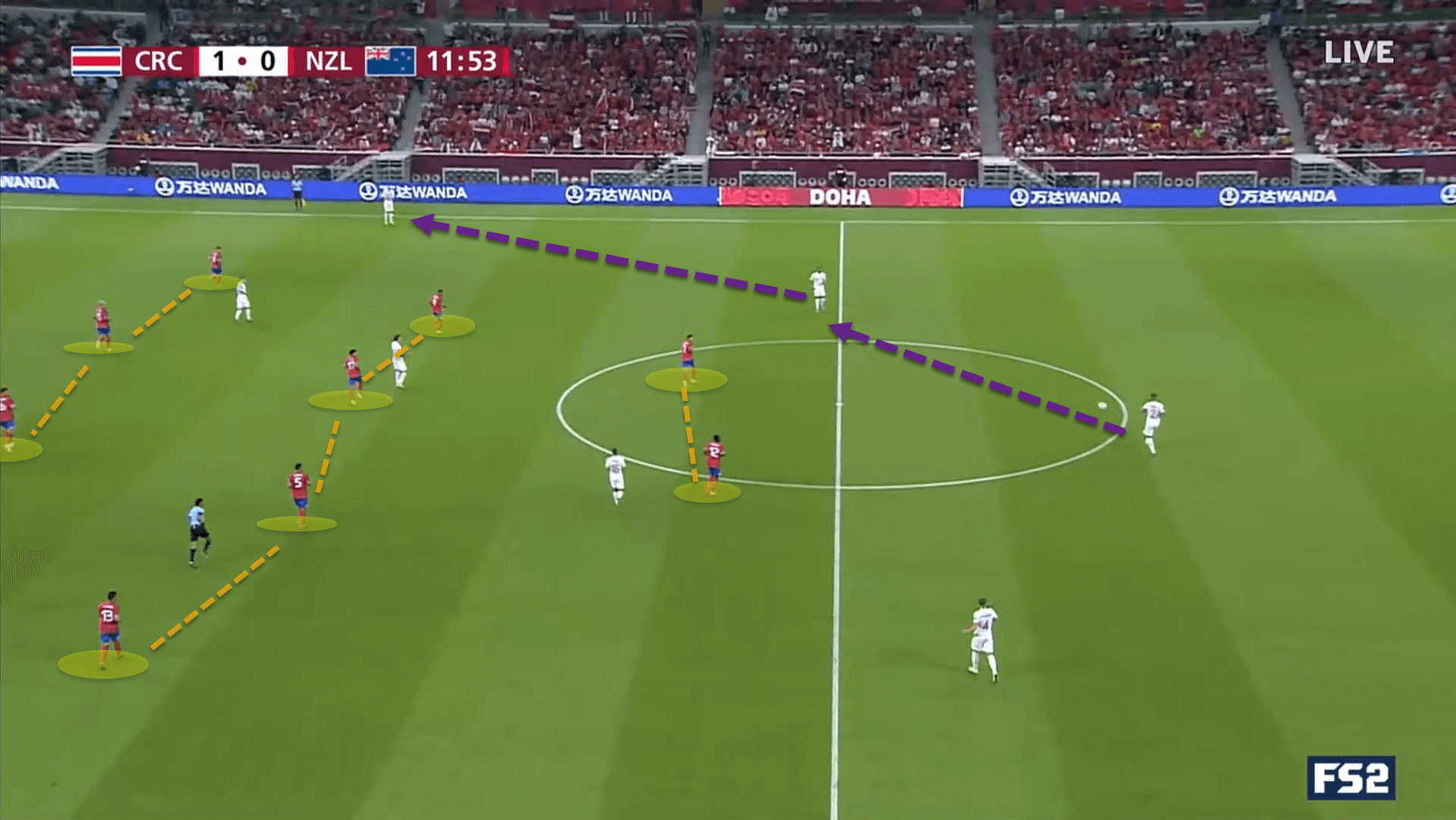
Their defensive gameplan was simply to compact the central areas, deny access into these spaces, and to force New Zealand to play out to the wide areas where there was a lot of space to play into given the narrowness of Costa Rica’s defensive block.
From there, Costa Rica would attempt to press their opponents aggressively to regain possession before trying to hit New Zealand on the break. 72 percent of the Ticos’ defensive duels took place in the halfspaces and wide areas, with 54 percent coming in their own defensive third.
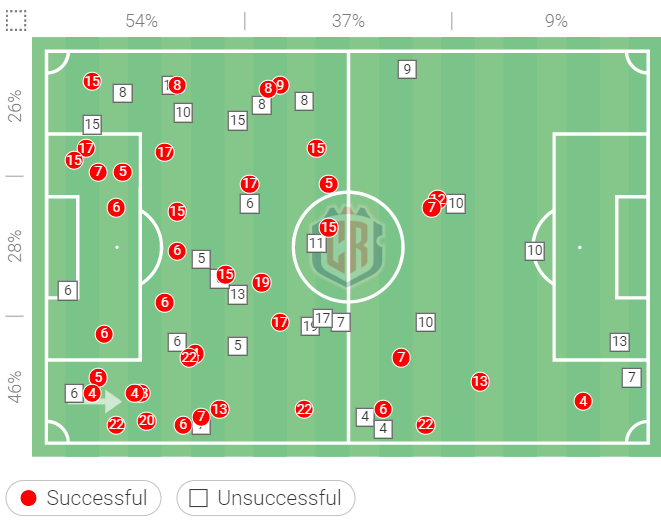
In possession, Suárez’s instructed his team to go direct to the centre-forwards, either in transition or through a settled positional attack.
This is evident in the team’s progressive passing map. The most utilised progressive passing routes for Costa Rica was from their right centre-back and right-back to Campbell in the forward line:
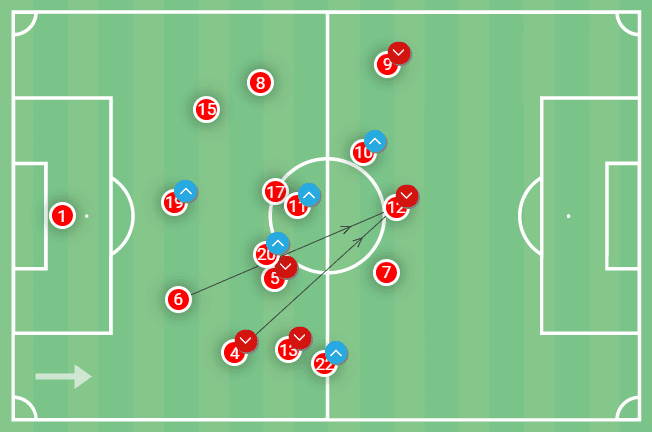
Costa Rica’s front four were not the most physically imposing players in the world. However, Suárez trusted their ability to hold off onrushing defenders when the ball was played to their feet with their backs turned to the goal.
Costa Rica’s goal actually came from this as Contreras managed to hold off Tuiloma’s pressure, and slide in Bennette who was running in behind before latching onto the pass and gliding a lowly cross along the floor into the penalty area for Campbell to stroke home with a sumptuous finish into the bottom right-corner which eventually guided the Ticos into the World Cup for the third time running.
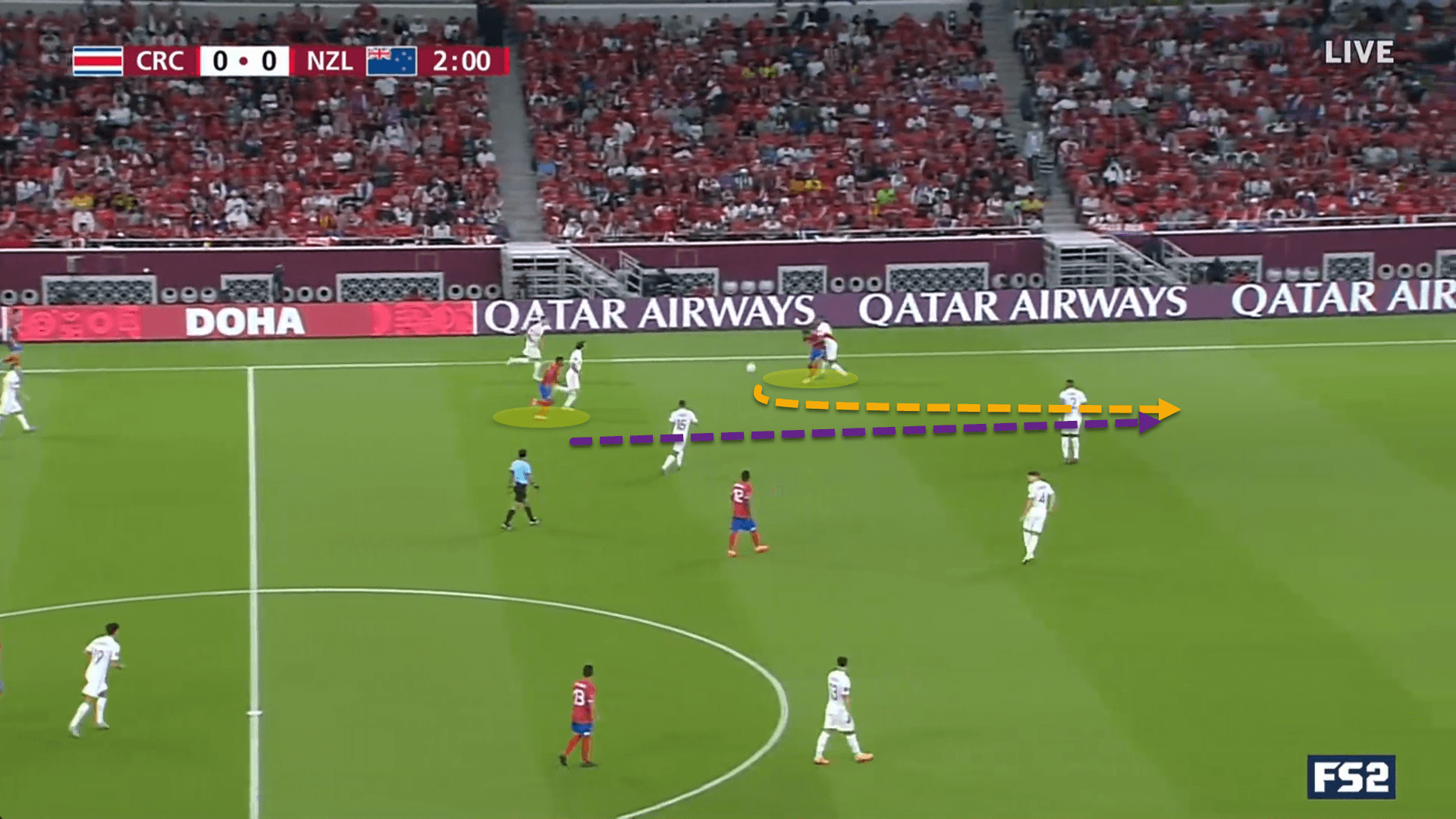
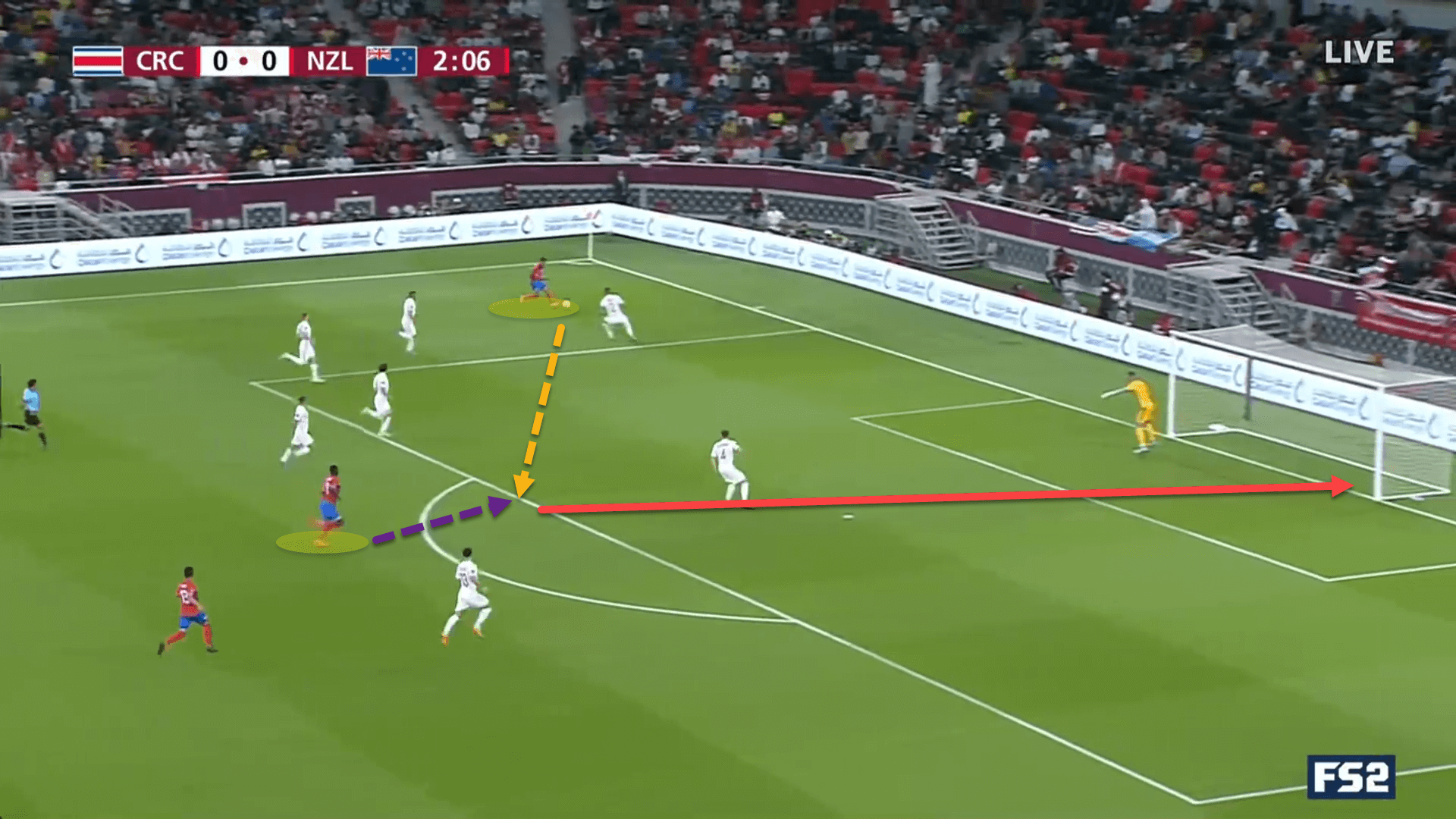
Wide overloads forcing a change
Nevertheless, despite the early goal, and the seemingly defensive set-up, Costa Rica were struggling to cope with New Zealand and their wide overloads which were causing a lot of damage.
The 3-4-2-1 is one of the most complete formations in the sport, offering width, depth, central occupation and wonderful balance defensively. This was certainly the case on Tuesday afternoon in the first half as New Zealand dominated proceedings, even at 1-0 down.
The Kiwis did so by constantly creating wide overloads using a diamond structure with their wingers, wingbacks, nearest centre-back and closest pivot player.
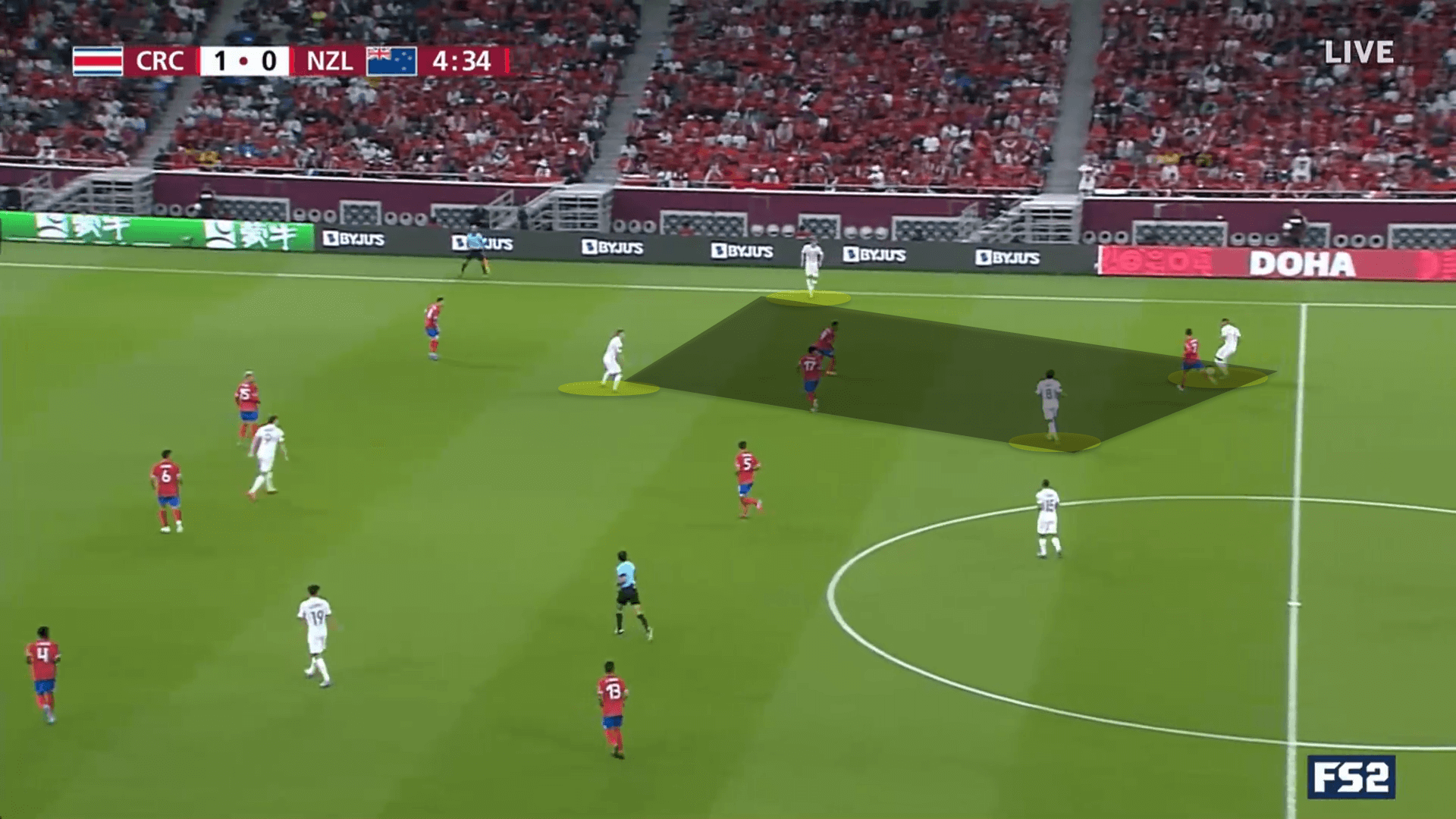
Throughout the game, as Costa Rica were very compact in the central areas, New Zealand used these wide overloads to great effect and were consistently breaking through their opponent’s defensive block down the flanks.
In total throughout the match, New Zealand had 50 positional attacks which is incredibly high. 40 of these 50 attacks came from the wide areas and Hay’s side were particularly dangerous down the right side.
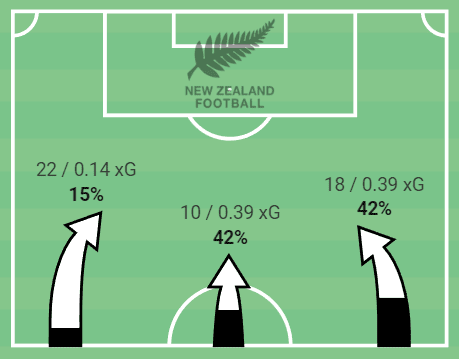
New Zealand’s aim for the crosses was always Chris Wood. The Magpie became a household name known for his aerial ability during his time under Sean Dyche at Burnley, and by putting crosses into the area, New Zealand played to the centre-forward’s strengths.
There was a common theme from these crosses though. Wood continuously peeled to the back-post to knock down a floated cross which allowed a teammate to latch onto an opportunity in the penalty area. This almost worked on several occasions.
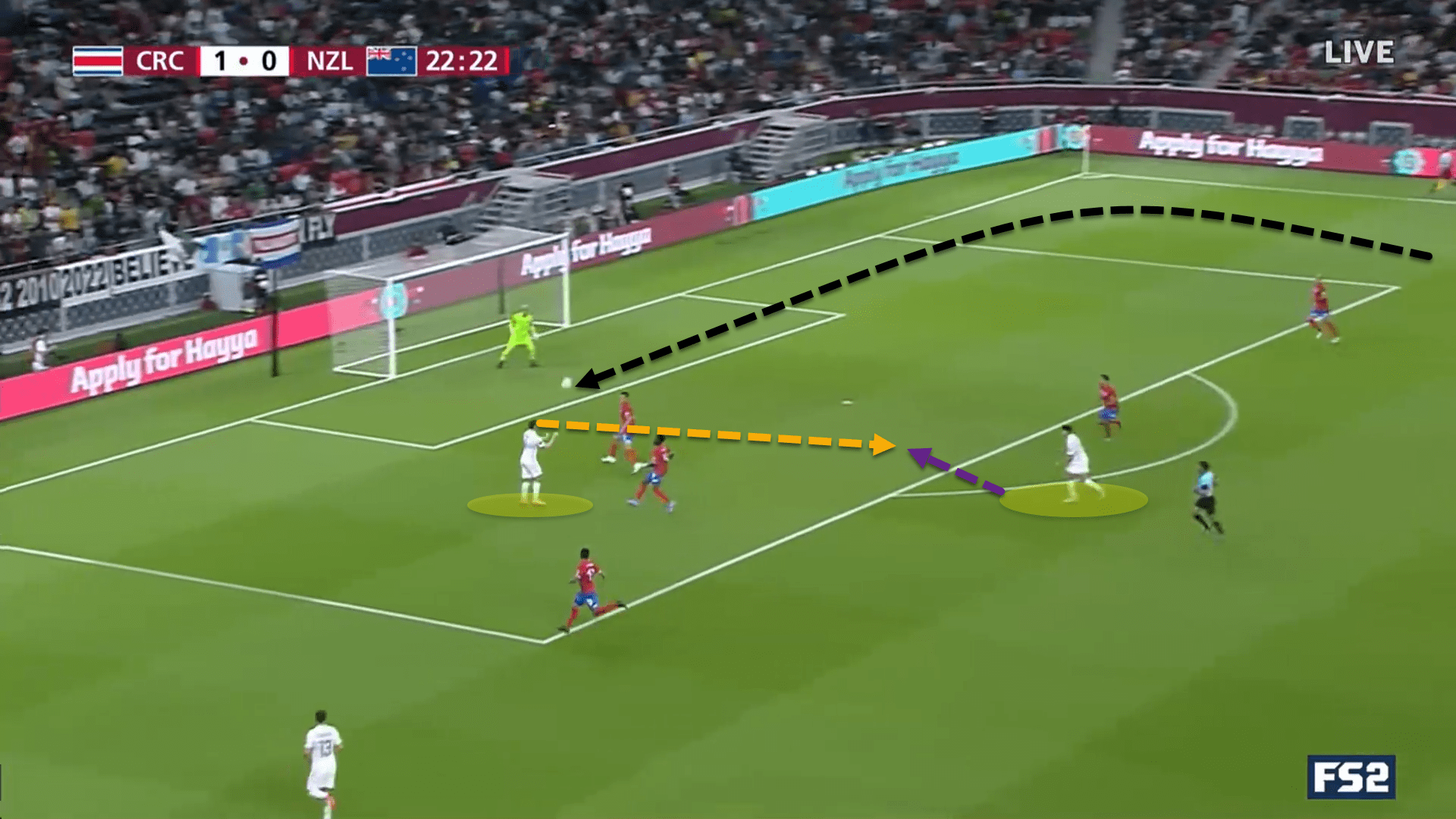
This tactic was clear from New Zealand’s crossing map from the game. A high volume of their crosses from the right side were placed to the back-post, where Wood was waiting to knock it down using his aerial prowess.
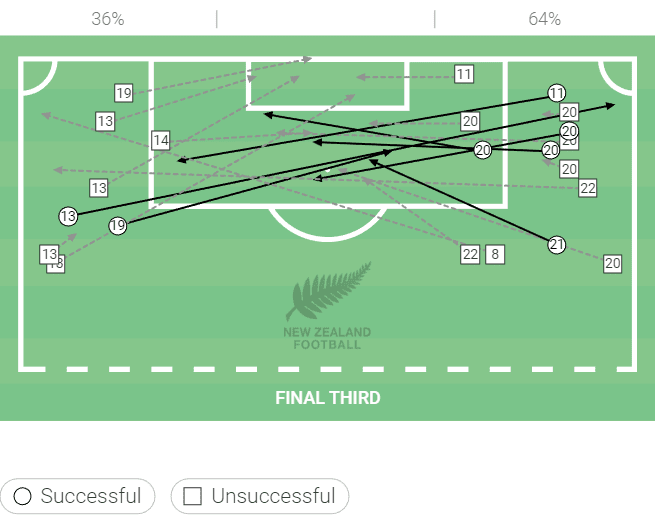
Costa Rica struggled significantly with this in the first half. New Zealand created three really good chances from these scenarios.
Rapid-fire chess
There is no solution for stopping a player like Wood in the air. How can you match a 6ft 5 beast in an aerial duel? Well, you can’t really. However, what you can do is stop the supply to him, which is what Suárez looked to do in the second half.
During settled positional attacks, New Zealand’s 3-4-2-1 became a 3-2-5 or 3-2-2-3 as the wingbacks pushed extremely high to create a front five.
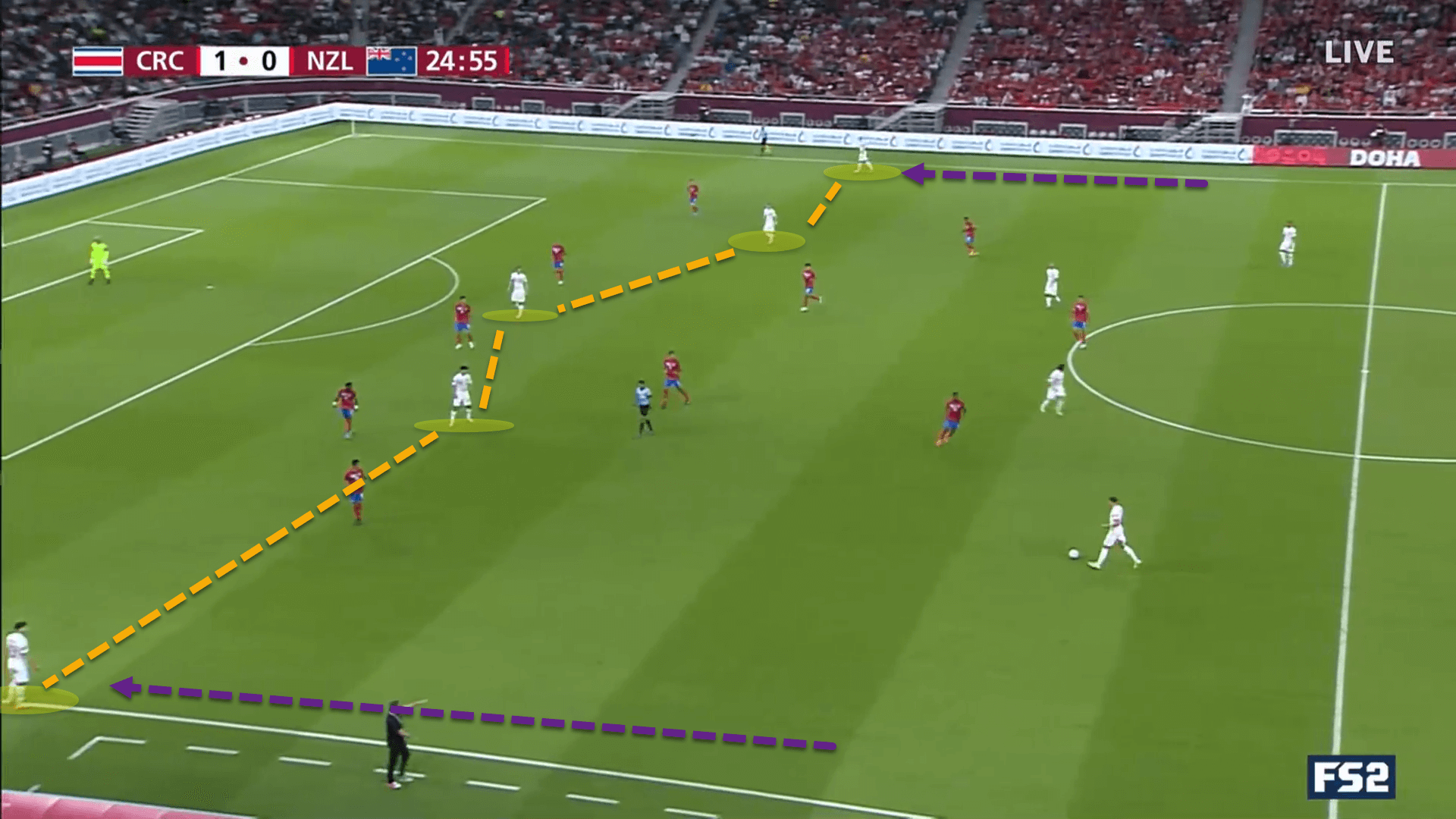
This was problematic for Costa Rica as it allowed New Zealand to occupy each one of their defenders and still essentially have an extra man free. If the Ticos’ midfield line was broken, New Zealand would have a 5v4 situation, allowing them to utilise the free man to get crosses into the area.
The ball supply into Wood needed to be chopped off and so, after the interval, Suárez made the change to a back five, matching Hay’s system and employing a 5-4-1 low block which allowed Costa Rica to play much more man-oriented across the backline.
To facilitate this, Bennette, Torres, and Fuller were replaced by Costa Rican legend Bryan Ruiz (number 10), Kendall Watson (19) and Carlos Martinez (number 22).
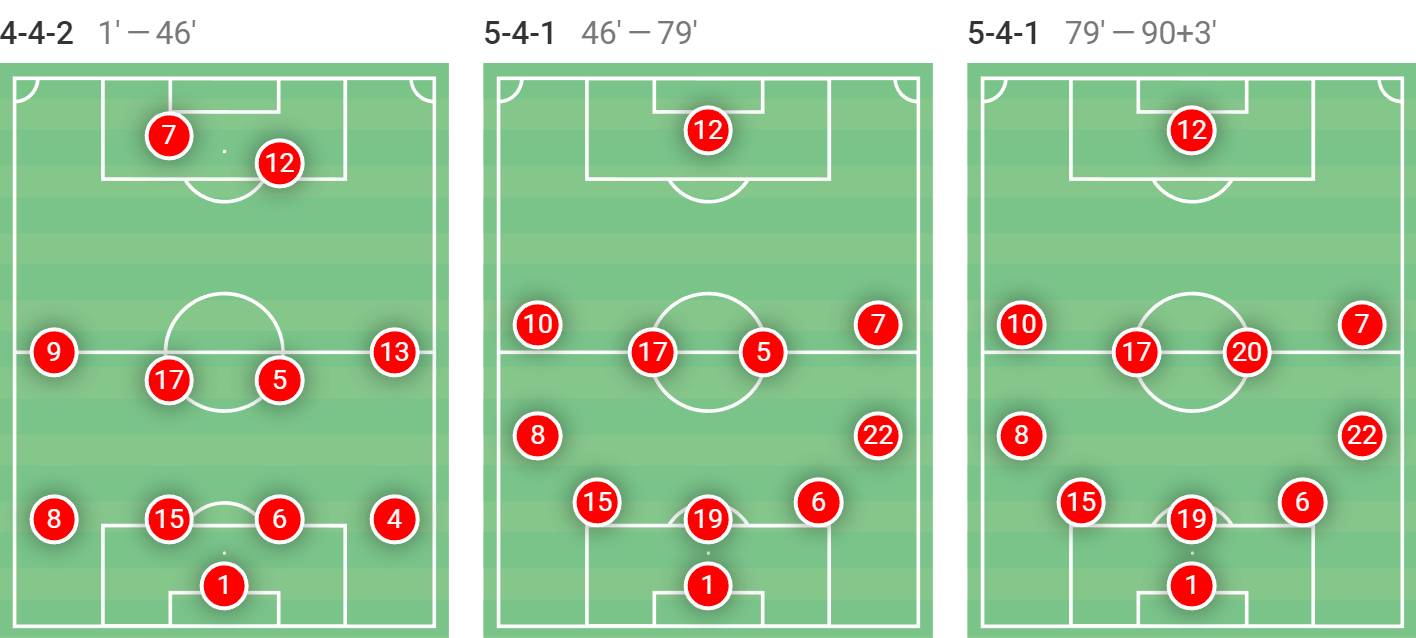
Costa Rica’s entire defensive approach changed too. As their structure had matched New Zealand’s, they began pressing much higher up the pitch, something that was non-existent in the opening 45 minutes of play.
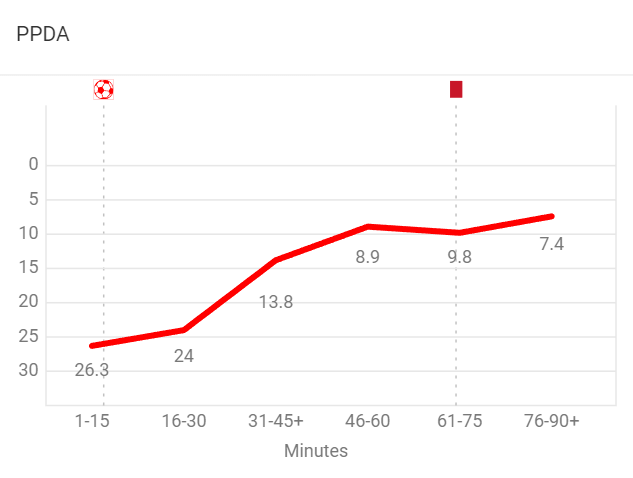
Compared to the first half, New Zealand’s PPDA dropped from 21.4 down to an average of 8.7 across the second half, a drastic change. With PPDA, the lower the number, the higher a team is pressing as the opposition is making fewer passes per their average possession.
As the two formations were matched up, Costa Rica were able to press in a man-to-man fashion, relying on individual duels to prevent New Zealand from progressing the play from deeper areas of the pitch.
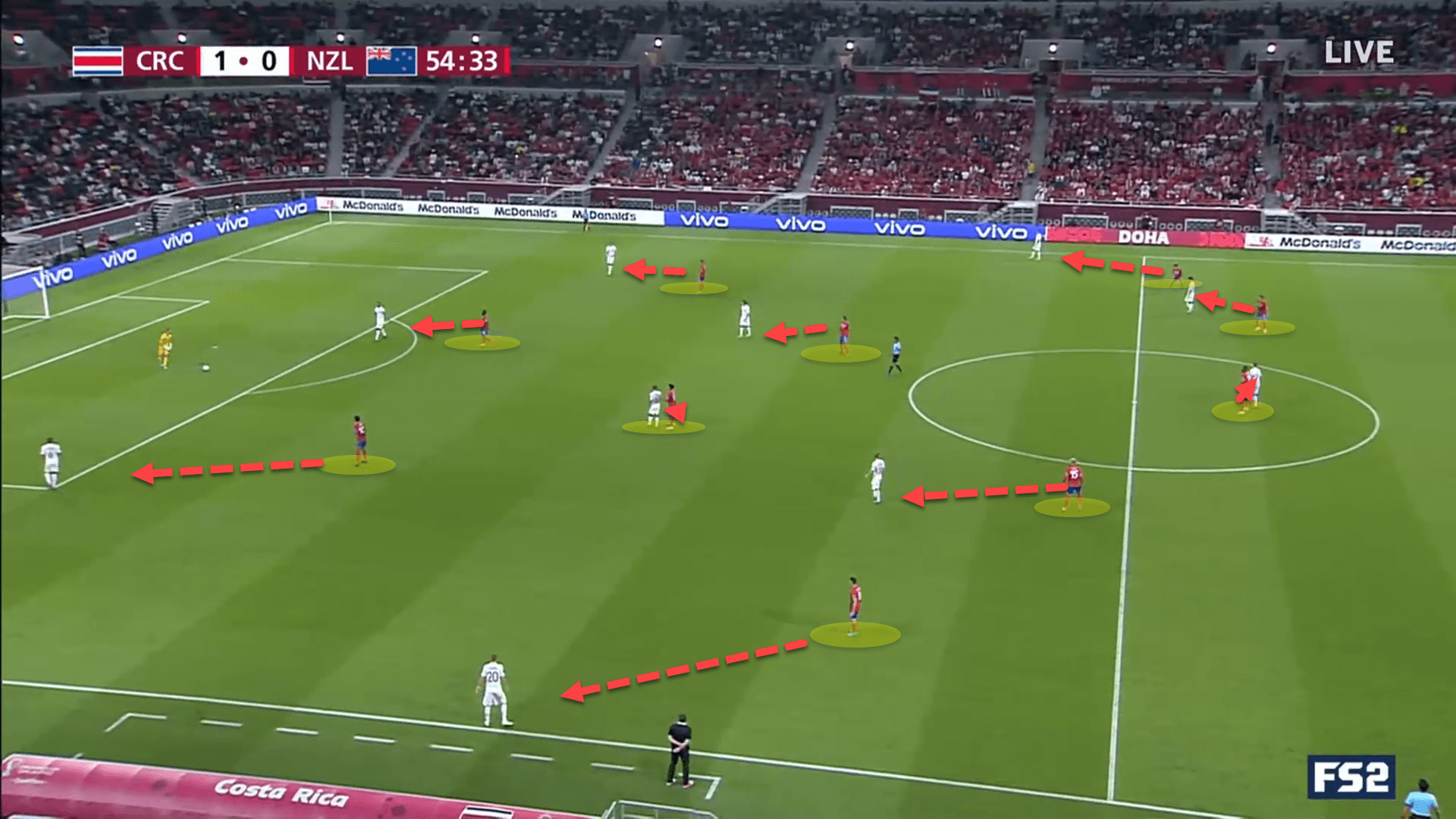
Now it was Hay’s turn to make a tactical switch. New Zealand were finding it more and more difficult to play out from the back due to Costa Rica’s new, tight man-marking pressing structure and so the Kiwis had to find a way to regain a competitive edge.
And they did. Briefly. Hay replaced Garbett and Greive with Ben Waine and Kosta Barbarouses. The former played much further forward as a second striker next to Chris Wood while the latter dropped into more of a number ‘10’ role, switching the shape to a 3-4-1-2. This began to cause Costa Rica issues in their high press.
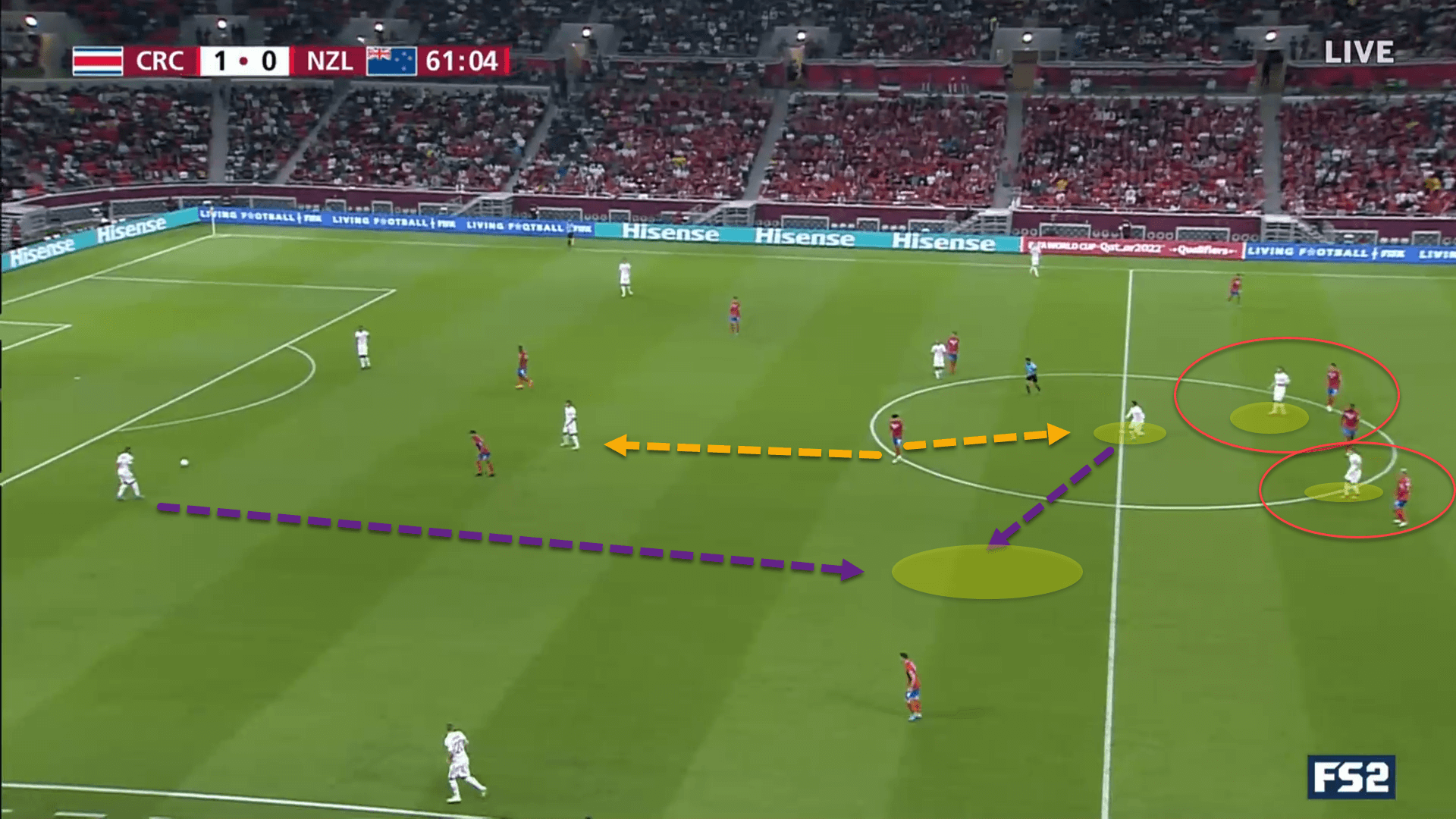
Waine and Wood would pin all three of the Ticos’ centre-backs and Barbarouses was handed a free license to roam behind Costa Rica’s midfield. This meant that Suárez’s double-pivot could no longer go man-for-man anymore and forced them to get overloaded 2v1 at times, creating a free man for easy ball progression.
Suárez made the perfect tactical switch and Hay countered it with an even better one. It was a real battle of the minds in Doha on Tuesday evening as the two tacticians were forced to constantly use their heads and make changes to respond to one another.
However, one man didn’t use his head – Barbarouses. Nine minutes after coming onto the field, he was sent his marching orders from the referee for a poor challenge on Francisco Calvo.
Hay’s final key strategic switch was to move to a back four and employ a 4-3-2 formation, hoping to get Wood on the end of a cross.
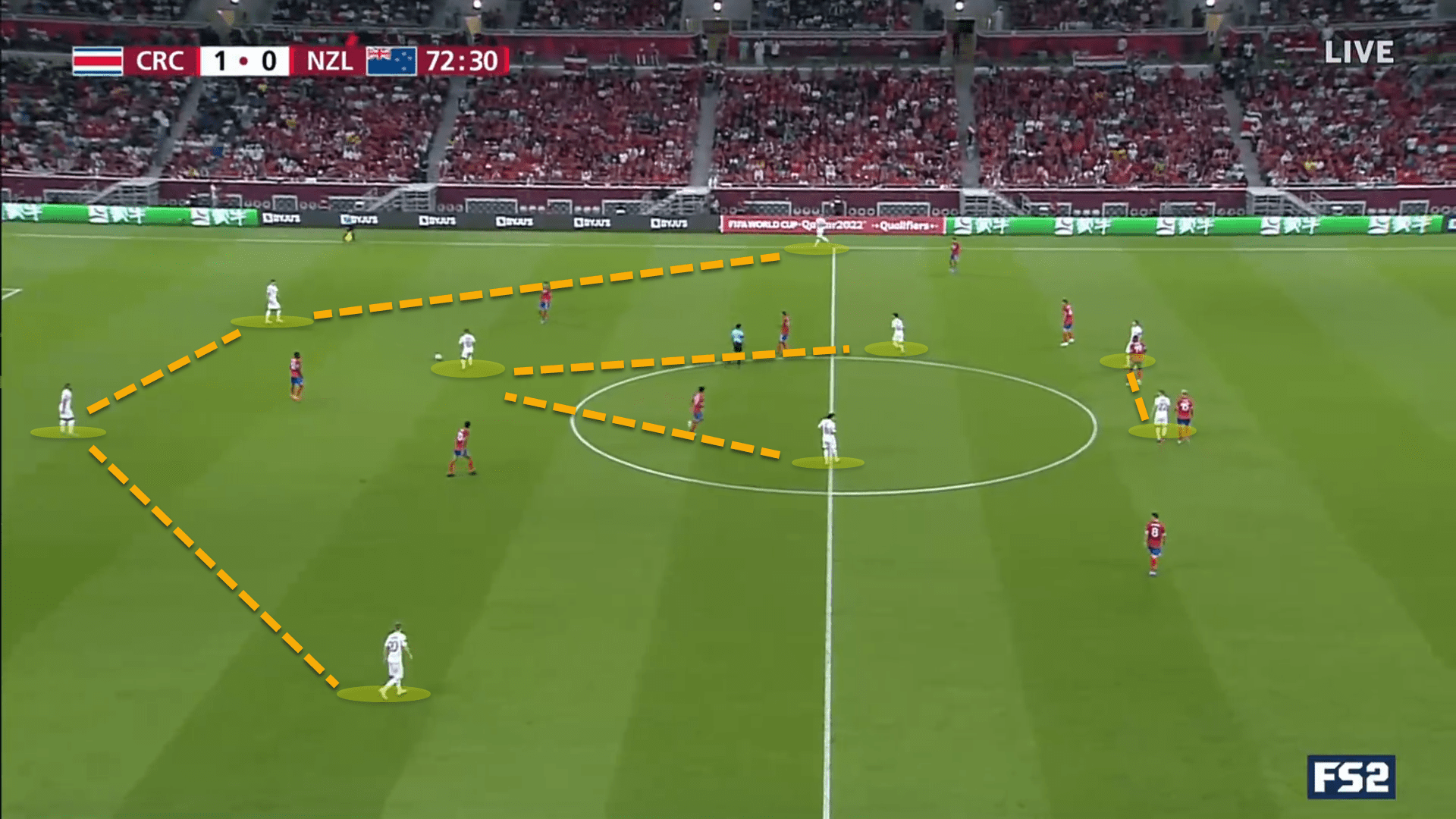
Conclusion
However, it wasn’t to be. Football is the cruellest, most beautiful game in the world. As the referee blew the final whistle, red shirts flooded onto the pitch in pure ecstasy while white tops collapsed in sheer devastation.
The game wasn’t a classic in terms of the overall quality or drama but was certainly a sight to behold for tactical purists as two excellent international coaches tried to one-up each other consistently throughout the match.
Costa Rica managed to qualify for the World Cup. Suarez’s men are heading to Qatar this winter, looking to replicate their form in 2014 where they reached the quarter-finals of the tournament, the country’s greatest ever feat to this day.






Comments